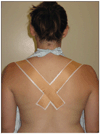Age-related hyperkyphosis: its causes, consequences, and management
- PMID: 20511692
- PMCID: PMC2907357
- DOI: 10.2519/jospt.2010.3099
Age-related hyperkyphosis: its causes, consequences, and management
Abstract
Synopsis: Age-related hyperkyphosis is an exaggerated anterior curvature in the thoracic spine that occurs commonly with advanced age. This condition is associated with low bone mass, vertebral compression fractures, and degenerative disc disease, and contributes to difficulty performing activities of daily living and decline in physical performance. While there are effective treatments, currently there are no public health approaches to prevent hyperkyphosis among older adults. Our objective is to review the prevalence and natural history of hyperkyphosis, associated health implications, measurement tools, and treatments to prevent this debilitating condition.
Level of evidence: Diagnosis/prognosis/therapy, level 5.J Orthop Sports Phys Ther 2010;40(6):352-360, Epub 15 April 2010. doi:10.2519/jospt.2010.3099.
Figures






References
-
- Ball JM, Cagle P, Johnson BE, Lucasey C, Lukert BP. Spinal extension exercises prevent natural progression of kyphosis. Osteoporos Int. 2009;20:481–489. http://dx.doi.org/10.1007/s00198-008-0690-3. - DOI - PubMed
-
- Balzini L, Vannucchi L, Benvenuti F, et al. Clinical characteristics of flexed posture in elderly women. J Am Geriatr Soc. 2003;51:1419–1426. - PubMed
-
- Benedetti MG, Berti L, Presti C, Frizziero A, Giannini S. Effects of an adapted physical activity program in a group of elderly subjects with flexed posture: clinical and instrumental assessment. J Neuroeng Rehabil. 2008;5:32. http://dx.doi.org/10.1186/1743-0003-5-32. - DOI - PMC - PubMed
-
- Birnbaum K, Siebert CH, Hinkelmann J, Prescher A, Niethard FU. Correction of kyphotic deformity before and after transection of the anterior longitudinal ligament--a cadaver study. Arch Orthop Trauma Surg. 2001;121:142–147. - PubMed
-
- Bouxsein ML, Melton LJ, Riggs BL, et al. Age- and sex-specific differences in the factor of risk for vertebral fracture: a population-based study using QCT. J Bone Miner Res. 2006;21:1475–1482. - PubMed
Publication types
MeSH terms
Grants and funding
LinkOut - more resources
Full Text Sources
Other Literature Sources
Medical
Research Materials
Miscellaneous

